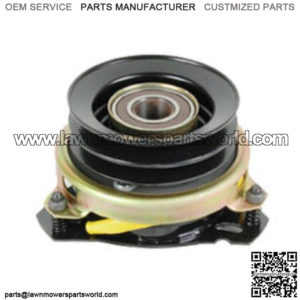Most Common Riding Lawn Mower Clutch Problems:
The Electric PTO is Not Getting the Voltage Needed, or the PTO Solenoid is Toast
If the solenoid switch that controls the electromagnetic clutch engagement is bad, you will not hear anything happen when you activate the switch. There are three common reasons for this: There could be a bad fuse, which is the easiest fix. The solenoid may not be getting enough voltage from the battery to engage, in which case you will want to test the voltage coming from the battery. The other possibility is that the solenoid is bad, and in this case, you will want to head down to your local small engine repair shop to obtain a new one.
The Clutch is Slipping, Damaged, or Fused Together
If you activate your PTO switch and you hear a squealing, screeching sound, disengage the PTO and turn off the mower. You may have something in the blades that is keeping them from turning, your PTO belt may be worn out, or worst-case scenario, you may have a lawn mower clutch problem. Whatever you do, NEVER GO NEAR THE BLADES WHILE THEY ARE SPINNING, OR THE PTO IS ENGAGED. It’s best to completely turn off the mower and remove the key before trying to service any part of the PTO system.
A Safety Switch Somewhere Else is Causing the Blades Not to Engage
There is the possibility that another safety mechanism or switch is keeping the PTO from engaging. There are multiple switches in most mowers to ensure that you are safely seated on the mower when the blades start spinning. This may be a safety switch in the seat, or possibly a switch in the emergency brake or transmission. Try shifting your mower into neutral, engaging and disengaging the emergency brake, and make sure your weight is centered on the seat while engaging the PTO switch. Sometimes the switch under the seat may go bad or get dirty, and it will not sense your weight on the seat. The blades won’t turn on if that’s the case.
Symptoms of a Bad PTO Clutch on Your Lawn Mower (Mechanical):
These symptoms may indicate a mechanical problem with the actual clutch of the mower.
The Clutch Makes Noise When Engaged
If this is happening, your clutch may have a bad bearing, the surface of the flywheel may not be in good condition, or your PTO belt or pulley may need replacement. The belt slipping may cause the noise, so the first thing to check would be that the belt is tight and not damaged.
The Clutch Causes the Engine to Rev Higher
If the engine is revving up higher when you engage the PTO, it becomes evident that the power transfer from the engine to the blades is not working as it should. This may indicate some of the same things mentioned above. Your actual clutch may have a bad bearing and not be spinning smoothly, causing the engine to use more power. The PTO pulley may also have a bad bearing which would cause the engine to supply more power to get it moving.
The PTO Clutch Starts, Then Immediately Stops, and Fuse is Blown
If the fuse to your PTO switch blows right away when you activate it, that could still indicate a mechanical problem. This could mean that the clutch was impossible for the motor to move, and the motor had to try and supply so much power that it blew the fuse. Your clutch may be seized up completely, there may be something stuck in the blades, or your PTO pulley may be seized up. Either way, you won’t be mowing until you figure out the problem.
Symptoms of a Bad PTO Clutch (Electrical):
The PTO Switch Makes No Sound When Activated
This can indicate that the actual switch is bad or is not receiving enough power from the battery. You will need to do some electric PTO clutch troubleshooting to fix this problem. Listed below are the possible problems to check for if you experience this. You will likely need a multimeter to check for these.
Check the Fuse – The fuse for the PTO System is the easiest part to check and change. It should not be burnt, and you should be able to see that there is still a solid connection.
Battery Voltage – The battery may not be supplying enough voltage to activate the solenoid. This is a common problem, as lawn mower batteries can lose charge while sitting.
PTO Solenoid – This is the actual electromagnetic switch that controls the clutch, and replacing this part is a little more in-depth. You can check for its function with a multimeter.
“Keyword”
“lawn mower clutch won’t disengage”
“lawn mower clutch replacement”
“how do i know if my lawn mower clutch is bad”
“how to replace lawn mower clutch cable”
“honda lawn mower clutch cable replacement”

